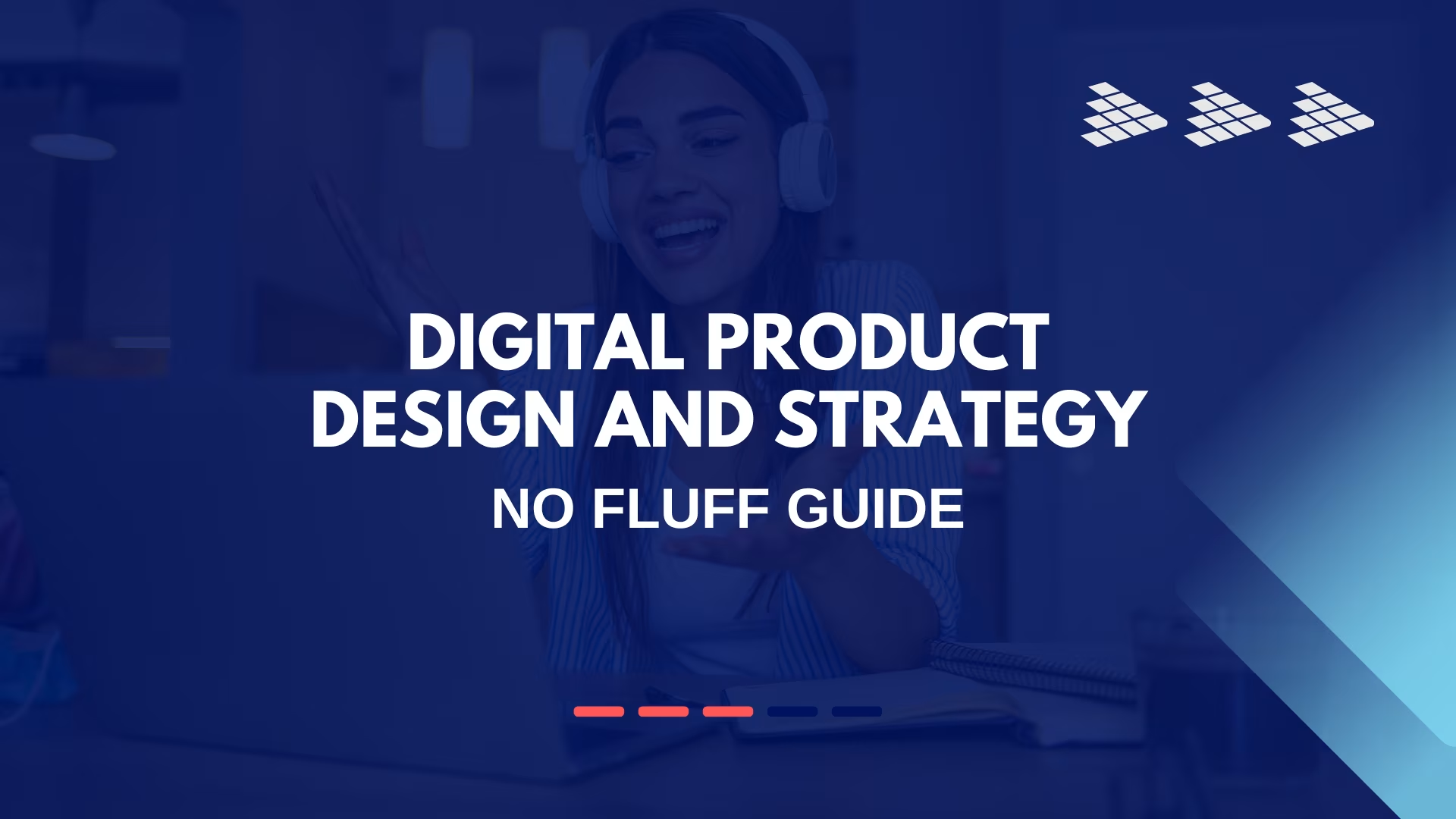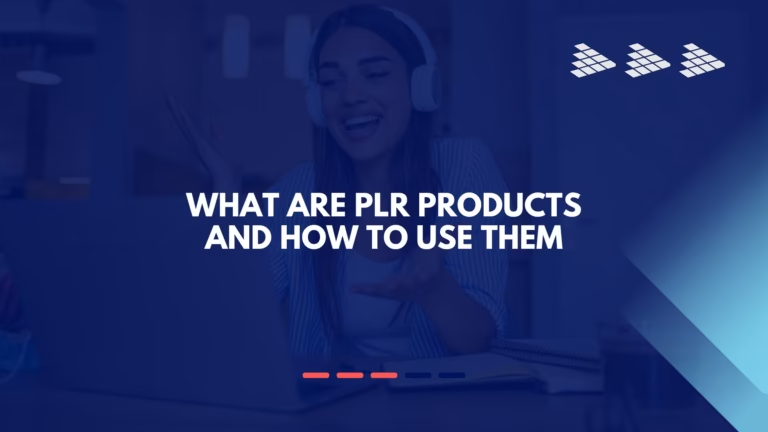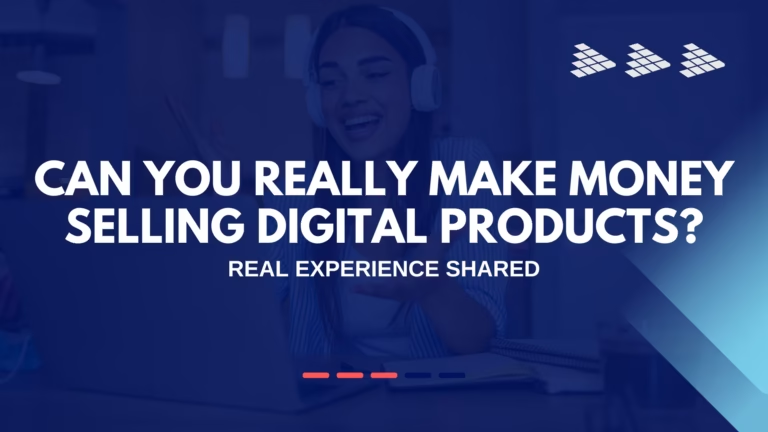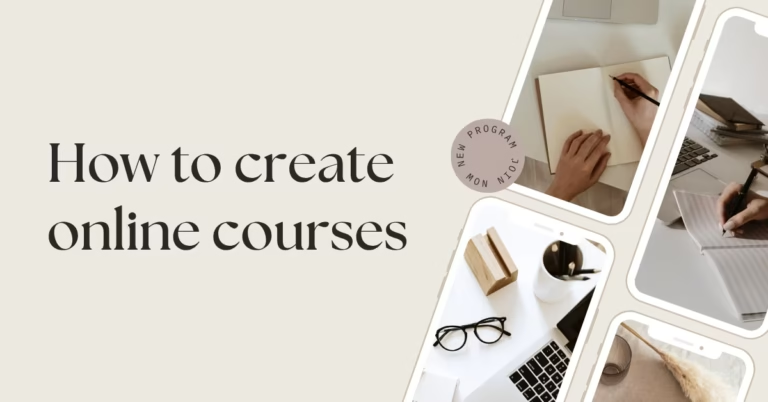Hey there! If you’ve ever felt confused about what digital product design and strategy actually mean, you’re not alone. I’ve been in the tech world for years, and I still see seasoned pros struggle with these concepts.
I was chatting with a designer friend recently who was feeling stuck. She said, “Despite my broader background, recruiters still view me mainly as a UI designer — even when I highlight how I bridge user needs, business goals, and technical constraints.”
Does that sound familiar? It’s a classic sign that someone is thinking about product design, but the world still sees them as a visual designer. That’s exactly what we’re going to untangle today. We’ll walk through what digital product design and strategy really are, how they work together, how to create a digital product and how you can use them to build things people truly love. Let’s dive in!
General Understanding of Digital Product Design and Strategy
What is digital product design, and how does it differ from UX/UI design?
This is the best place to start, and I like to explain it with a simple analogy.
- UI (User Interface) Design is all about the look and feel. It’s the colors, the fonts, the buttons, and the spacing. If your app were a car, UI would be the sleek paint job, the comfortable seats, and the layout of the dashboard. It’s about aesthetics.
- UX (User Experience) Design is about the overall journey. Is the car fun to drive? Is the dashboard intuitive? Does it get you from A to B without a headache? UX focuses on how a user feels when they interact with your product.
- Digital Product Design is the whole business of the car. It’s the market research that decided what type of car to build, the engineering specs, the safety testing, the marketing plan, and the sales strategy. A product designer worries about everything: the user’s needs, the company’s business goals, and the technical limits, from the first sketch to the car sitting in a customer’s garage.
The key difference is scope. Product design is a strategic role that connects the dots between design, business, and technology. It’s not just a step in the process; it’s a holistic mindset.
Why is having a product strategy essential for digital success?
Imagine you’re building a house without a blueprint. You might have the best bricks and beautiful windows, but you could end up with a staircase that leads to a wall. A product strategy is your blueprint.
It’s your master plan that answers the critical questions:
- Who are we building this for?
- What problem are we solving for them?
- Why will they choose our solution?
- How will we know if we’ve succeeded?
Without this strategy, you’re just guessing. You might spend a year building a gorgeous, perfectly functional app that nobody needs. A clear, strong product strategy aligns your entire team and ensures that every single design decision pushes you toward a common goal.
How do digital product design and strategy work together in a digital product lifecycle?
They’re like a rock band—strategy is the rhythm section (bass and drums) keeping the beat and direction, while design is the lead guitar and vocals, creating the memorable experience people connect with. You can’t have a hit song with just one.
Throughout the product development lifecycle, this partnership plays out in four key stages:
- Discovery & Ideation: Strategy identifies the user problem and market opportunity. Design helps visualize potential solutions through sketches and rough concepts.
- Definition & Planning: Strategy sets the key goals and success metrics. Design creates wireframes and prototypes to map out the user’s journey to meet those goals.
- Design & Development: Design builds the high-fidelity, beautiful interface. Strategy acts as a compass, constantly checking that the work still aligns with the core business objectives.
- Launch & Growth: The product goes out into the world. Strategy analyzes user data and performance. Design uses those insights to create new iterations and improvements.
As one savvy Reddit user put it, this often involves “collaborating closely with a cross-functional team” including product managers and engineers to define the product’s direction.
What are the key stages of digital product design strategy and development?
While every team is slightly different, the process generally follows these steps:
- User Research & Discovery: Understanding the user and the problem.
- Ideation & Strategy: Brainstorming solutions and defining the product vision.
- Wireframing & Prototyping: Creating the blueprints and interactive models.
- Visual & UI Design: Crafting the final look and feel.
- Development & Testing: Building the product and ensuring it works.
- Launch & Deployment: Releasing it to the public.
- Post-Launch Analysis & Iteration: Using data to make it better and better.
Notice how it’s a cycle, not a line? Launch isn’t the end; it’s just the beginning of the next loop of improvement.
How do successful brands approach digital product design and strategy in 2026?
In 2026, it’s no longer enough to just have a great idea. Successful brands treat their digital product strategy as a living, breathing thing. They are:
- Hyper-focused on User Outcomes: They don’t just build features; they solve specific, painful user problems.
- Data-Informed, Not Data-Driven: They blend quantitative data (like metrics) with qualitative insights (like user interviews) to make decisions.
- Embracing Flexibility: They use agile processes to adapt quickly to user feedback and market changes. The “set it and forget it” strategy is long gone.
- Prioritizing Inclusivity: They build products that are accessible and welcoming to a diverse global audience from day one.
Process & Frameworks for Digital Product Design
What are the most effective frameworks for digital product design and strategy (e.g., Design Thinking, Lean UX, Agile)?
Frameworks are like recipe books—they give you a proven structure so you don’t have to invent cooking from scratch. Here are the three heavyweights:
- Design Thinking: This is a human-centered superstar. Its five phases—Empathize, Define, Ideate, Prototype, and Test—force you to deeply understand the human problem before you fall in love with a solution.
- Lean UX: Perfect for fast-paced startups. It’s all about speed and learning. You build a Minimum Viable Product (MVP), measure how it performs, and learn from the results. It’s about continuous improvement, not creating a “perfect” product in a vacuum. A designer on Reddit mentioned how relearning Lean UX helped them reframe their work to show more business impact.
- Agile: This is a project management method where work is done in short, focused bursts called “sprints.” It allows teams to adapt to change quickly and deliver value to users consistently, which is why it pairs so well with Lean UX.
How do you conduct user research before designing a digital product?
This is the foundation, and it doesn’t have to be a huge, scary, formal project! The designer from our intro struggled because she hadn’t led formal research, but she had used “lightweight validation methods like UAT and observational testing.” That absolutely counts!
Here’s how you can start gathering those critical user insights:
- User Interviews: Have real, honest conversations with people from your target audience. Ask “why” a lot.
- Surveys: Gather quantitative data from a larger group to spot broader trends.
- Usability Testing: Give people a prototype and watch them try to use it. Where do they get stuck? What confuses them? This is pure gold dust for a designer.
- Competitive Analysis: See what others in your space are doing. You can learn from their successes and their mistakes.
A brilliant piece of advice from the Reddit thread was to gain experience by “reaching out to startup companies and offer services for cheap” or doing pro-bono work. This hands-on practice builds your confidence and gives you real stories to tell.
What’s the role of prototyping and wireframing in digital product design and strategy?
Think of these as your product’s rough drafts. They are your most powerful tools for validating ideas before your engineering team writes a single line of code.
- Wireframes are the skeleton. They’re simple, often black-and-white layouts that show the structure: where the button goes, what’s the most important text, how the information is organized.
- Prototypes are an interactive model. They simulate the real user experience, allowing people to click through flows. It’s a cheap, fast way to answer the question, “Does this actually work for the user?”
How can teams validate ideas before building a digital product?
Building the wrong thing is the biggest waste of time and money in tech. Validation is how you avoid that. Here’s how:
- Create a Low-Fidelity Prototype: Use a tool like Figma to mock up the core idea.
- Test with Real Users: Get your prototype in front of 5-8 people from your target audience.
- Listen to Feedback: Don’t get defensive. Listen to what they say, but more importantly, watch what they do. Are they able to complete key tasks?
- Pivot or Proceed: Use the feedback to either refine your idea (iterate) or scrap it entirely (pivot). This is the core of the Lean UX cycle.
What KPIs or metrics should you track for digital product performance?
If you can’t measure it, you can’t improve it. Key Performance Indicators (KPIs) are your product’s vital signs. The ones you track depend on your goals, but common ones include:
- User Engagement: Are people using it? (e.g., Daily/Monthly Active Users).
- Retention: Do people come back after their first visit?
- Conversion Rate: What percentage of users take a key action (like signing up or buying)?
- Task Success Rate: Can users easily do what they came to do?
- Customer Satisfaction: How happy are they? (e.g., Net Promoter Score – NPS).
Design & User Experience is a Must for Digital Product Design and Strategy
How do you create a user-centered design for digital products?
It sounds simple, but it’s a constant practice: get out of your own head and into your user’s.
Every single design decision, from the biggest feature to the tiniest icon, should be made with the user’s needs, goals, and context in mind. It means constantly asking “Why?” Why this color? Why this button placement? Why this workflow? If the answer is “because I like it,” you need to go back to your user research.
What are the most common design mistakes in digital products today?
After years of using and reviewing apps, I see the same few culprits again and again:
- Designing for Yourself: This is the number one rule. You are not your user.
- Overloading with Features: Also known as “featuritis.” A simple, focused product that does one thing well is better than a complex, confusing one.
- Ignoring Loading Times: The most beautiful animation in the world is worthless if it makes your app slow and frustrating.
- Inconsistent Design: Using different buttons, fonts, or styles throughout the app makes it feel unprofessional and hard to learn.
How do accessibility and inclusivity fit into digital product design?
This is absolutely non-negotiable in 2026.
- Accessibility (A11y) means designing products that can be used by people with a wide range of abilities. This includes things like adding alt-text to images for screen readers, ensuring high color contrast for users with low vision, and making your site fully navigable by keyboard.
- Inclusivity goes a step further. It’s about considering the full range of human diversity—race, gender, age, language, and more—to ensure your product is welcoming and usable for everyone.
It’s not just the right thing to do; it’s smart business. You’re opening your product up to a much larger audience and building a better experience for all users in the process.
How do you balance aesthetics and functionality in product design?
This is the classic struggle. My rule of thumb is: function first, then beauty.
A beautiful design that doesn’t work is useless. A functional design that’s ugly is unpleasant to use. The magic happens when they support each other. The aesthetic should enhance the functionality—using color to guide the eye, using whitespace to reduce cognitive load, using micro-interactions to provide feedback. The goal is a product that works so seamlessly that the user doesn’t even notice the design—they just accomplish their goal.
How can UX research influence overall business strategy?
This is where UX proves its immense value. When you bring real, qualitative insights from user research to the leadership table, you can shape the company’s direction.
For example, if user interviews repeatedly show that people are using your fitness app to train for a specific event, that’s a massive strategic insight! The UX researcher can go to the leadership team and say, “Our users are crying out for a ‘training plan’ feature. This could be a major new premium tier and significantly increase user retention.” Suddenly, UX isn’t a cost center; it’s a core strategic advantage.
Business & Growth Strategy for Digital Products
How do you align digital product design and strategy with business goals?
This is the secret sauce of modern product design. Every screen you design should be traceable back to a business objective.
- Business Goal: Increase premium subscriptions.
- Design Action: Create a clear, helpful, and non-annoying path within the app that showcases the benefits of going premium and makes the upgrade process dead simple.
You have to learn to speak the language of business. Instead of saying, “I made the button green,” you say, “I changed the call-to-action button to a higher-contrast green, which improved click-through rates by 7%, directly supporting our Q3 goal of increasing subscription conversions.”
What’s the difference between product strategy and product roadmap?
People mix these up all the time, but the distinction is powerful.
- Product Strategy is the “Why” and the “What.” It’s your high-level vision and the problems you’re solving. “We will become the go-to budgeting app for freelancers by automating expense tracking.”
- Product Roadmap is the “How” and the “When.” It’s the tactical plan that outlines the key features and initiatives you’ll build to achieve that strategy over the next few quarters.
The strategy is your destination. The roadmap is your travel itinerary.
How can digital design help increase user retention and engagement?
Great design doesn’t just attract users; it keeps them coming back. Here’s how:
- Onboarding: A well-designed onboarding flow teaches users the value of your product quickly, hooking them from the start.
- Intuitive Navigation: If users can find what they need effortlessly, they’ll stay longer and get more value.
- Delightful Micro-interactions: Small, satisfying animations and feedback (like a “whoosh” when an email is sent) create an emotional connection.
- Personalization: Designing experiences that adapt to user behavior (like a “Continue Reading” prompt) makes the product feel tailor-made for them.
What’s the best way to prioritize features during the MVP phase?
With a thousand ideas and limited resources, how do you choose? A simple and effective framework is the ICE Score:
- Impact: How much will this feature move the needle on our key goal? (Score 1-10)
- Confidence: How sure are we that it will have that impact? (Backed by research? Score 1-10)
- Ease: How difficult/expensive is it to build? (Score 1-10, where 10 is very easy)
Add up the scores for each feature. Focus on the highest-ranking ones. This forces you to think about value and effort objectively.
How can startups build a winning digital product design and strategy on a limited budget?
Having a small budget can actually be a superpower—it forces you to be lean and focused.
- Solve One Problem Brilliantly: Don’t try to be everything to everyone. Find the one core problem you solve better than anyone else and pour all your energy into it.
- Embrace the MVP: Your first version should have the absolute minimum set of features that make your product usable and valuable. Nothing more.
- Use Free Tools: You don’t need fancy software. Use Figma for design, Google Forms for surveys, and Zoom for user interviews.
- Talk to Users Relentlessly: This is free and is the most valuable thing you can do. Get feedback early and often. As one Redditor found, sometimes you just need to “work with a friend who was building an app” to get that crucial hands-on experience.
Conclusion: Your Journey Starts Now
Remember my designer friend from the beginning? After she worked on reframing her skills and speaking with more conviction about her strategic impact, she landed a great contract role as a product designer. She realized that sometimes, “failing early can mean a mismatch in culture or expectations, and that is okay.”
The path to mastering digital product design and strategy isn’t about knowing everything. It’s about a shift in perspective. It’s about moving from “How should this look?” to “Why should this exist?” and “How does this help our users and our business win?”
You don’t need a fancy title to start thinking like a product designer. You can start today.
So, what’s the first step you’re going to take? Share your thoughts or questions in the comments below—I’d love to hear from you




